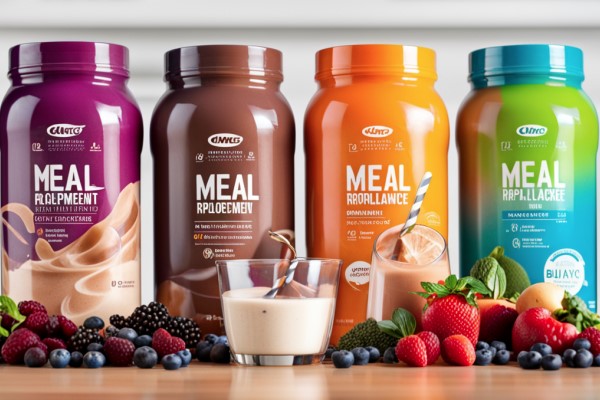Navigating the wide world of nutrition can be challenging, especially when considering supplements like meal replacement shakes. Did you know these drinks are packed with essential nutrients and cater to various diet needs? This guide will provide straightforward information on what meal replacement shakes are, how to incorporate them into your dietary routine, and their pros and cons.
Ready for a shake-up in your daily meals? Let’s dive in!
Key Takeaways
- Meal replacement shakes are designed to provide essential nutrients and can be convenient for individuals with busy schedules or those looking to manage their weight.
- Different types of meal replacement shakes include protein shakes, weight loss shakes, smoothies, and nutritional supplements. Choosing the type that aligns with your specific dietary goals and needs is important.
- To properly use meal replacement shakes, replace one or two meals with a shake each day. Follow the recommended portion sizes on the packaging and consider adding whole foods to your diet for complete nutrition.
- Meal replacement shakes offer convenience and potential support for weight loss efforts. However, it’s important not to rely solely on them for sustenance as they should be used alongside whole-food meals. Some meal replacement shakes may contain added sugars or artificial ingredients that should be monitored.
What Are Meal Replacement Shakes?
Meal replacement shakes are specially formulated drinks that provide essential nutrients while replacing a full meal.
Definition and purpose
Meal replacement shakes serve a dual purpose: to provide a quick, convenient source of balanced nutrition and to help control calorie intake. Typically packed with essential vitamins, minerals, fiber, and protein, these drinks are designed to mimic the nutritional profile of a full meal.
They come in handy for individuals who have busy schedules or those looking to manage their weight. While not intended to replace all meals daily, they offer an alternative when you need something healthier than fast food or skipping meals altogether.
Nutritional content
Meal replacement shakes are designed to provide a balanced and convenient source of nutrition in a single serving. These shakes typically contain a combination of macronutrients such as protein, carbohydrates, fats, essential vitamins, minerals, and fiber.
The nutritional content can vary depending on the brand and formulation, but they generally aim to meet your body’s daily calorie needs while providing a good source of nutrients. It is important to choose meal replacement shakes that align with your specific dietary goals and needs, whether it be weight loss or simply maintaining a healthy lifestyle.
Different types available
Different meal replacement shakes are available, each with its unique formulation and purpose. Some common types include:
- Protein shakes: These shakes are designed to provide a high amount of protein, essential for muscle growth and repair. They often contain ingredients like whey protein or plant-based proteins like soy or pea.
- Weight loss shakes: These meal replacement shakes are formulated with lower calories and higher fiber content to help support weight loss efforts. They often contain ingredients like fiber, vitamins, and minerals, along with a reduced calorie count.
- Smoothies: While not strictly classified as meal replacement shakes, smoothies can be a convenient and nutritious option for replacing a meal. They typically contain a mix of fruits, vegetables, yogurt or milk, and additional protein or nutritional supplements if desired.
- Nutritional supplements: Some meal replacement shakes are designed to provide a complete balance of nutrients, including carbohydrates, proteins, fats, vitamins, and minerals. These can suit individuals with increased nutritional needs due to medical conditions or dietary restrictions.
How to Use Meal Replacement Shakes
To properly use meal replacement shakes, incorporate them into your daily routine by replacing one or two meals with a shake.
Incorporating them into your daily routine
To incorporate meal replacement shakes into your daily routine, follow these steps:
- Start by identifying the meal or snack you want to replace with a shake.
- Choose a meal replacement shake that aligns with your nutritional needs and goals.
- Set aside a specific time each day to drink your meal replacement shake, such as breakfast or lunch.
- Prepare your shake according to the instructions on the packaging, using the recommended amount of liquid and powder.
- Enjoy your meal replacement shake slowly and mindfully, savoring each sip.
- If desired, add additional ingredients to enhance the taste and nutrition of your shake, such as fruits, vegetables, or nut butter.
- Consider using a shaker bottle or blender to ensure the shake is well-mixed and smooth.
- Keep track of your calorie intake from the meal replacement shake to ensure it fits your daily caloric needs.
- Listen to your body’s hunger and fullness cues after consuming a meal replacement shake, adjusting portion sizes as needed.
- Make sure to include whole foods for complete nutrition and variety.
Proper portion sizes
To get the most out of meal replacement shakes, it’s important to know the proper portion sizes. Each shake will have recommended serving instructions on the packaging, so follow these guidelines.
Typically, one serving is around 8-12 ounces of liquid mixed with one scoop or packet of powder. It’s crucial not to exceed this amount as it can lead to consuming more calories and nutrients than necessary.
Remember that meal replacement shakes can be a convenient way to control portion sizes and monitor calorie intake, but they should not replace all meals throughout the day. It’s essential to incorporate whole foods into your diet for a balanced nutritional intake.
Combining with whole foods
To maximize the nutritional benefits of meal replacement shakes, combining them with whole foods is important. While meal replacement shakes provide an easy way to get essential nutrients, they should not completely replace whole-food meals.
Instead, they can be used alongside a balanced diet as a supplement or snack. By incorporating fresh fruits, vegetables, lean proteins, and healthy fats into your meals and snacks throughout the day, you ensure your body receives a wide range of vitamins, minerals, and fiber.
This combination helps promote satiety, supports digestion, and provides long-lasting energy. So remember to pair your meal replacement shake with nutrient-dense whole foods for optimal nutrition.
Pros and Cons of Meal Replacement Shakes
Discover the benefits and potential drawbacks of meal replacement shakes for weight loss and convenience.
Benefits for weight loss and convenience
Meal replacement shakes offer several benefits for weight loss and convenience. Firstly, these shakes are designed to be low in calories while still providing essential nutrients, making them a convenient option for those looking to lose weight.
Replacing a high-calorie meal with a shake can effectively reduce your overall calorie intake without sacrificing nutrition. Additionally, meal replacement shakes are easy to prepare and consume on the go, making them ideal for individuals with busy lifestyles or those who struggle with meal planning and preparation.
They provide a quick and convenient solution for individuals seeking a healthy option when time is limited.
Potential drawbacks and considerations
While meal replacement shakes can be a convenient option for those trying to lose weight or maintain a healthy lifestyle, there are some potential drawbacks and considerations to remember.
First and foremost, meal replacement shakes should not replace all meals in your day. It is important to still include whole foods in your diet to ensure you get various nutrients.
Additionally, some meal replacement shakes may contain high levels of added sugars or artificial ingredients, so it’s important to read the labels carefully and choose products with minimal additives.
Conclusion
In conclusion, meal replacement shakes can be a convenient and effective tool for weight loss and maintaining a balanced diet. They provide a quick and easy way to consume essential nutrients while controlling calorie intake.
However, it’s important to remember that they are not meant to replace whole foods entirely and should be part of a healthy eating plan. As with any dietary supplement, it’s best to consult a healthcare professional before incorporating meal replacement shakes into your routine.
FAQs
- What are meal replacement shakes?
Meal replacement shakes are specially formulated drinks that provide balanced nutrients, including proteins, carbohydrates, fats, vitamins, and minerals. They are designed to replace one or more regular meals and can be used as a convenient alternative when time or access to traditional meals is limited.
2. How should I use meal replacement shakes?
Meal replacement shakes can be used as a substitute for breakfast, lunch, or dinner. Simply mix the recommended serving size with water or milk according to the instructions. It is important to remember that meal replacement shakes should not replace all your meals long-term and must be part of an overall healthy eating plan.
3. What are the pros and cons of using meal-replacement shakes?
Some potential benefits of using meal replacement shakes include convenience, portion control, and the ability to ensure you’re getting essential nutrients in a controlled manner. However, it’s important to note that they may not provide the same satisfaction as whole foods and may lack certain essential nutrients in a varied diet.
4. Are there any potential drawbacks or considerations when using meal replacement shakes?
While meal replacement shakes can be useful for certain situations, it’s crucial to remember that they should not entirely replace whole foods in your diet over an extended period. Relying solely on these drinks may lead to missing out on vital dietary components such as fiber from fruits and vegetables. It’s always advisable to consult with a healthcare professional before making significant changes in your diet or relying heavily on meal replacements.















